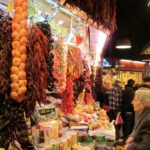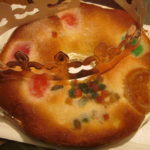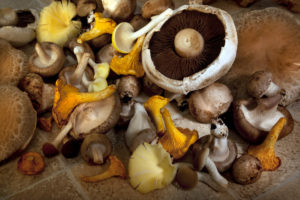It’s fascinating how many of our family’s traditions are centered around food.
Let’s start with last year’s Christmas. We’d been to Spain a few years earlier and went to a small taverna near our lodging. When we walked in, we were greeted boisterously by a British couple who’d obviously been drinking there for quite some time. They were, in BritSpeak, pissed. (which means sloshed, not angry) They encouraged us to sit at the bar, which we did. But we left a few seats between us. Had we sat clear across the small bar, we could still have easily (and uncomfortably) heard our “hosts.”
Meanwhile, the bartender/ham cutter (cortador de jamón) had not even acknowledged our presence. More loudmouthed turistas were not what he wanted to see. When I asked for recommendations in my stumbling but passable Spanish, he acted as if I spoke German. He served us, but reluctantly.
It took maybe an hour but we won him over. We (quietly) enthused over the tapas we chose. We (quietly) enjoyed our wine. We (quietly and reluctantly) answered the bellowed questions from our neighbors down the bar.
Gradually, our bar and hamtender started to tell us which meats to have him slice from, which of the many tapas in the case before us would be tastiest, and which wines complemented our tapas. Success! Our drunken English friends at last departed. We had one of the most memorable evenings of our lives and some of the best food. And knew we’d want to try serrano ham again someday.
Someday came last Christmas! Costco had a sale on dry-cured Serrano ham. It came with a stand and a knife for slicing and instructions, which were vital.
Because it was dry cured, it could be stored at room temperature, with a cloth covering it, so we didn’t have to worry about refrigerator space, which the ham would have filled.
The ham, or jamón, was delicious. A new tradition, we concluded!
Did I mention that the ham was huge?
Christmas dinner with our daughter and her husband was a delight and we deemed our purchase of jamón a success. Then we realized how much was still on the bone.
We enjoyed that ham for at least two months. We ate it alone, sliced from the bone, on crackers, with cheese, in soup, in casseroles, with giant Greek beans, with black beans. We ate ham for breakfast, lunch and dinner.
We’ll try a different meat this year, so this is one time a taste didn’t lead to a tradition.
Now Picture Us Back in Spain
We did, however, encounter a few other new traditions during that visit to Spain.
It was approaching midnight when we arrived in Marbella at the stroke of midnight, New Year’s Eve, after a long drive south from Barcelona. We’d saved the grapes we’d bought at La Boqueria on Las Ramblas in Barcelona for the first Spanish tradition we wanted to experience.
As we drove into town and found our resort, we were greeted by a near-midnight sky filled with fireworks. We felt so honored by their welcome.
We rushed to our room to carry out Spanish tradition #1: According to the superstition-slash-tradition, if you eat twelve grapes before the chiming of midnight on New Year’s Eve ends, one grape and one chime for each month, you will have good luck all year.
The clock chimed, we chewed. Another chime, another chew and swallow. I might have made it to four or five! Still, we laughed a lot and as I recall, our year went well anyway. Hey! Neither of us choked on a grape.
That tradition’s one we keep each New Year’s Eve. With about the same success rate on fast swallowing of grapes.
A few days later, on January 5th, we went to a parade to mark the start of the Festival of the Three Kings. We chose one in a small town outside Marbella. Even in a village, the parade is a big deal. People on lots and lots of floats pelt bystanders with candy. At 5 feet seven inches, I don’t think of myself as particularly tall, and my husband Mark is not huge at just under six feet. But we loomed above most of the other parade-goers! Our height made us the best targets for pelting candy at. Ouch! We gathered the candy and gave it to the amused people near us.
After the parade, we went to the village square to eat. Of course, so did everyone else in town, their children and their dogs. We waited a long time for our meal. They even came out and apologized to us for the delay! We didn’t mind the wait. It was an adventure to watch the children dashing around the square and eventually we ate a great meal.
(Photo of the parade)
The next day, January 6th, is the day for the Rosca de Reyes, a circular sweet bread sprinkled with sugar and dried fruits. Hidden inside is a tiny plastic baby. Whoever finds it is monarch for the day, entitled to be waited on hand and foot. My husband, chewing carefully, discovered the prize and I crowned him King.

Here in Tucson are bakeries where you can buy Roscas de Reyes in various sizes, so we’ve adopted the annual tradition.
Traditions Found Stateside
Another fun New Year’s tradition we discovered in New Orleans is eating Hoppin’ John with black-eyed peas on New Year’s for good luck, along with collard greens. Some pickier eaters might not consider collard greens good luck, but I love them. Here’s a recipe that combines collard greens with cabbage to sweeten the bitterness of the collards. If not good luck, this dish ensures good digestion!
I may have to send my Adventure Calls characters to New Orleans so Madrone can learn to cook Hoppin’ John. Hoppin’ John is easy, particularly if you use canned or frozen black-eyed peas rather than cooking the peas from dried. It’s basically black-eyed peas, onions and smoked pork (or pancetta or salt pork) served over rice with hot sauce.
Here’s the Collard Greens & Cabbage Recipe.
COLLARDS WITH CABBAGE
1 large bunch collards
Half of a head of green cabbage
1/4 pound slab bacon or regular bacon, diced
1/2 medium onion, diced
1 tablespoon red pepper flakes
2 tablespoons kosher salt, divided
2 cups chicken broth, divided
Wash the collards well, cut away the ribs, roll up the leaves and slice into strips. Cut away and discard the cabbage core, then cut cabbage into slices. Keep the collards and cabbage separate.
Divide the bacon between 2 large pots over medium heat. Cook until fat has rendered but bacon isn’t crisp. Remove bacon with a slotted spoon and set aside. Turn heat down under one pot, add 1 cup chicken broth, a tablespoon of salt and about 4 cups of water and bring to a boil. Add the cabbage and about half the bacon, reduce heat, cover and simmer about 30 minutes, until tender.
Add onion and pepper flakes to the fat in the second pot and cook until the onion has softened. Add 1 cup chicken broth, a tablespoon of salt and about 6 cups water. Add collards to the pot with remaining bacon. Bring to a boil, reduce heat and simmer about 1 hour, until tender.
When the cabbage is tender, remove it from the pot with a slotted spoon, draining the liquid. Place it on a cutting board and chop finely with a large knife. Set aside.
Remove collards from the second pot with a slotted spoon, saving the cooking liquid. Place them on a cutting board and mince them.
Mix the minced cabbage and collards and return them to the pot with enough of the cooking liquid to make a mixture that is juicy but not too soupy. Reheat and serve hot, with hot sauce or peppered vinegar on the side.
Here’s a PDF of this recipe.



